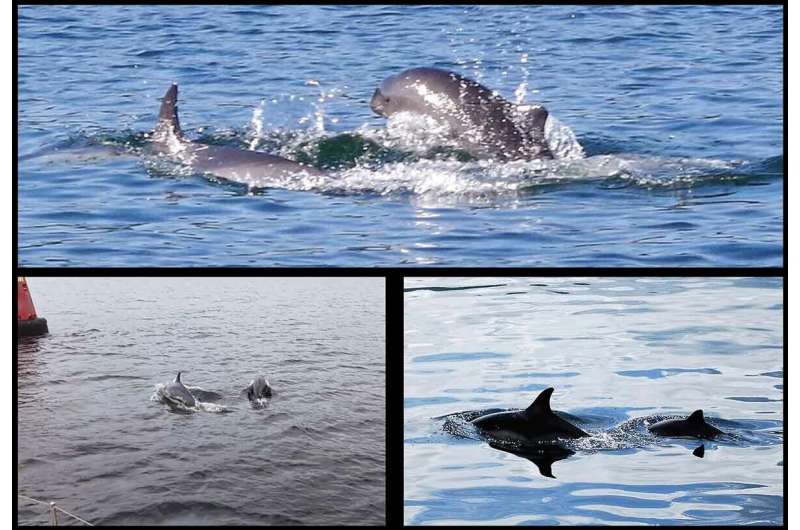Traveling together. Solitary common dolphin, locally known as Kylie, traveling together with a harbor porpoise (Top: photo by D. Nairn, 2018. Bottom left: photo by P. Nichols, 2017. Bottom right: photo by G. Patterson, 2009). All pictures were taken off Cumbrae, in the Fairlie/Hunterston Channel, in the Firth of Clyde, West Scotland. Credit: Bioacoustics (2022). DOI: 10.1080/09524622.2021.1982005
A team of researchers from the University of Strathclyde, Clyde Porpoise CIC and CESIMAR–CCT CENPAT-CONICET, has found evidence of a lone dolphin attempting to communicate with porpoises. In their paper published in the journal Bioacoustics, the group describes audio recordings of a dolphin living among porpoises in the Firth of Clyde and what they believe to be its attempts at communication.
The Firth of Clyde is a saltwater inlet on the west coast of Scotland that is home to many marine creatures, including harbor porpoises—and at least one dolphin. The dolphin, which locals have named Kylie, lives near navigational buoys in the Hunterston/Fairlie channel in close proximity to a pod of harbor porpoises. The people living in the area noticed that Kylie quite often spent time interacting with the porpoises, which led the researchers to wonder if perhaps she had learned to communicate with them. To find out, they dragged a hydrophone behind a yacht multiple times over the years 2016 to 2018.
Differentiating sounds made by dolphins and porpoises, the researchers note, is difficult because there are few physical movements involved. Dolphins make sounds by pushing air from their lungs through what has come to be known as their monkey lips—a muscular structure somewhat similar to vocal cords in humans. This produces sounds similar to letting air out of a balloon—dolphin whistles. Dolphins can also make clicking sounds using their nasal cavities. Prior research has shown that the primary means of communication between dolphins is whistling. In listening to the recordings of Kylie, the researchers found no whistling at all; instead, she produced sounds similar to those made by porpoises—high-pitched clicks.
Further study of the recordings revealed a back-and-forth communication of sorts between Kylie and some of the porpoises, which would pause to listen as the other clicked. The researchers acknowledge that they do not know if Kylie is actually speaking the same language as the porpoises—they note it could be analogous to a human barking with a dog—but they are confident that she was attempting to communicate in some fashion with the porpoises (though she has not been seen for over a year).
More information: Mel Cosentino et al, I beg your pardon? Acoustic behaviour of a wild solitary common dolphin who interacts with harbour porpoises, Bioacoustics (2022). DOI: 10.1080/09524622.2021.1982005
© 2022 Science X Network






















